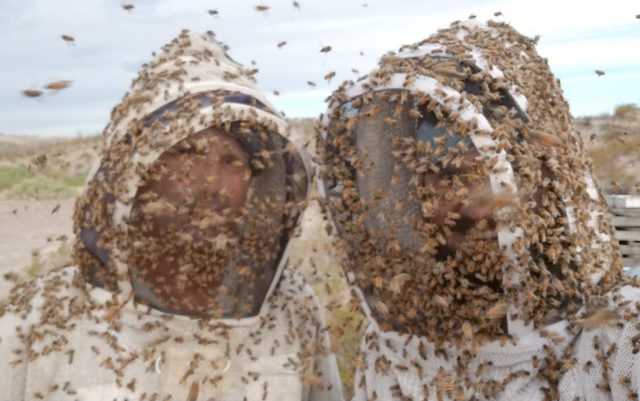
Southern Colorado’s San Luis Valley is as rugged as it gets. It’s bordered by the Sangre de Cristo and the San Juan mountains; anywhere that’s not covered in peaks or sand is used for agriculture.
It’s a far cry from Rising Sun, Indiana, where Laura Haefeli grew up. Her family’s farmhouse on the Ohio River peeked across the Kentucky border through lush trees, which are in short supply in Del Norte, Colorado, her home of 22 years. Like the little hamlet at the western edge of the San Luis Valley, though, Rising Sun was a small agricultural town. This suits Haefeli, who married into a family with beekeeping in its blood.
Laura’s husband, Tom, is a native of Monte Vista, Colorado, where his family has kept bees for generations. Although he left the San Luis Valley for college and worked as a pilot for a number of years, eventually — as Tom tired of making the commute to Denver and Laura became busier with three children and a robust running career — in the early 2000s, the couple realized it was time for a change.
“It just wasn’t sustainable,” Laura says of the time her family spent apart during those years. So the Haefelis did what Haefelis had done since Tom’s great-grandfather emigrated from Switzerland in 1919: they turned their attention to the bees. Their oldest son, John, now sells beeswax beauty products from Haefeli bees whose hives are scattered around the valley, and they opened a storefront in Del Norte, where they continue to sell honey from their hives, just as Great Grandma did in the mid-20th century.
A lot has changed in the intervening century, but the Haefelis still bring their bees down to Grandpa’s property in the milder climate of Presidio, Texas, where they stay into the new year. At the end of January, the crew packs up the hives and ships them to California’s San Joaqin Valley, where they have a pollination contract with an almond grower.
“Farming practices today are monoculturally centered,” Tom explains. “We grow vast amounts of the same crop in a very concentrated area, and almond trees are no different. So you have 80 percent of the world’s almonds growing in a six-week period in California, and the rest are in Spain.”
It’s why beekeepers must ship their bees to specific areas across the country and why almonds and almond products are so expensive, especially as the honeybee populations that pollinate them increasingly fall victim to colony collapse disorder (CCD).
“We’re losing 30 to 40 percent of our colonies a year,” Tom says, adding that a decade ago, it was closer to 10 percent. CCD, in which adult bees inexplicably leave their colonies, has begun to abate somewhat, but the huge array of chemicals (particularly fungicides) in the environment kill the microbiota in bees’ stomachs, preventing them from digesting nutrients.
The monocultural practices Tom mentions, too, are part of the problem. He compares it to living on a single food source for an entire month. You can survive on nothing but steak for 30 days, sure — “but it’s not good for you.”
Haefeli Honey, like many small beekeeping operations, has done its best to alleviate a problem over which it has little control. The Haefeli hives now occupy only about half the space they used to; Tom has moved the bees to the fringes of the San Luis Valley, farther from heavy industrial farming. Some of his beekeeping peers are planting vast swaths of wildflowers, which vary the bees’ diet somewhat.
“Unfortunately, the big corporate farms” — which might have 80,000 colonies, compared to the Haefelis’ 1,200 — “aren’t doing that,” Tom says. Happier bees make happier honey, he adds.
But simply knowing the bees are well cared for is only part of the reason to buy honey from a local producer. According to the National Honey Board, products must list additional ingredients, but it’s murky what constitutes an “incidental additive.” Corn syrup or cane sugar can make up as much as 49 percent of a product marketed as honey. Plus, the Haefelis say, many manufacturers import tons of cheap honey from China; it’s mixed with commercially produced American honey for a final product that, according to Tom, is “vastly inferior” to what a small-scale manufacturer produces.
All this gives Tom pause when he’s asked about the future of his beekeeping operation. The potential for their oldest son, John, to take over the family business is certainly there — it simply comes down to “whether we want to continue,” he says. As a beekeeper and honey packer, Haefeli Honey bears the combined weight of agricultural regulations, the state health department, the USDA’s Farm Service Agency and the EPA.
But, “we’re in a unique position,” Laura says. The loss of bees worldwide has brought a great deal of attention to beekeeping, and sustainable shoppers want sustainably sourced honey more than ever.
The best way to keep Colorado beekeeping operations — and the towns they help sustain — from drying up? Tom says: “Buy local.”














